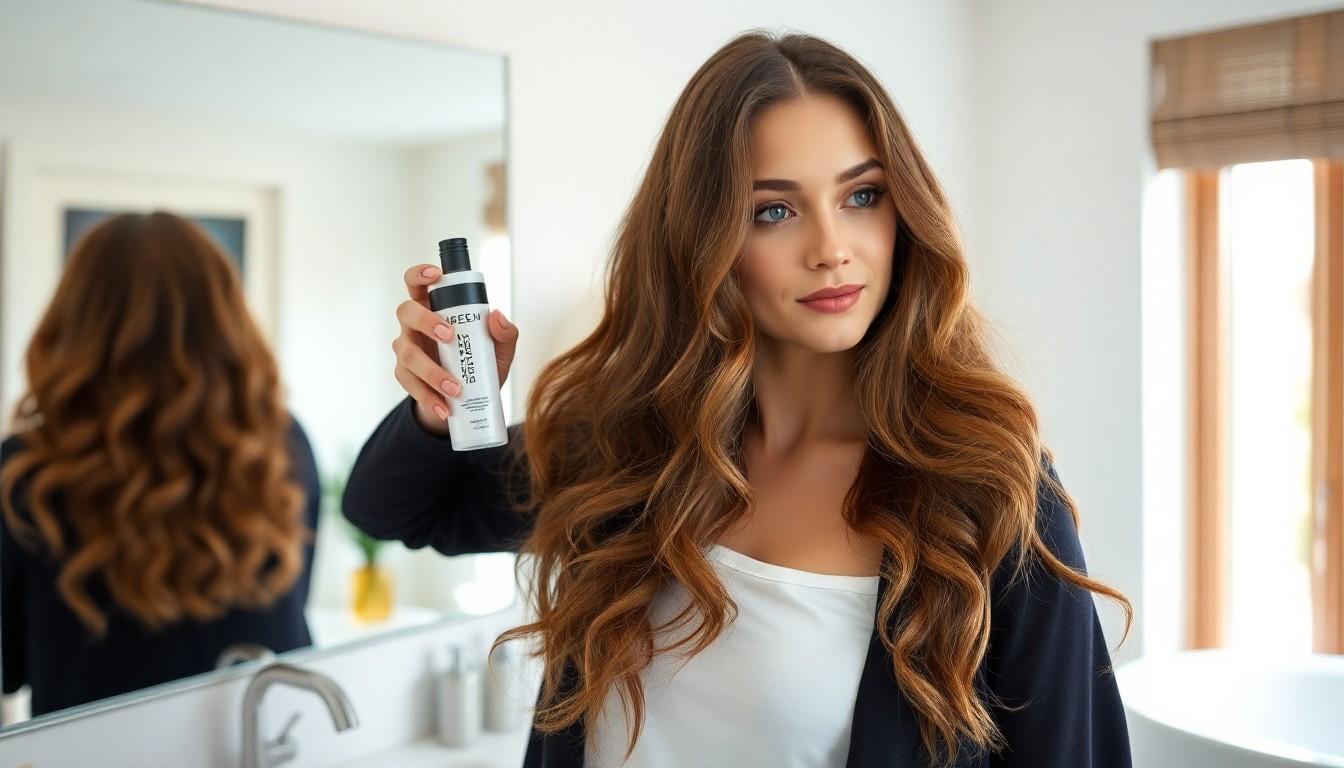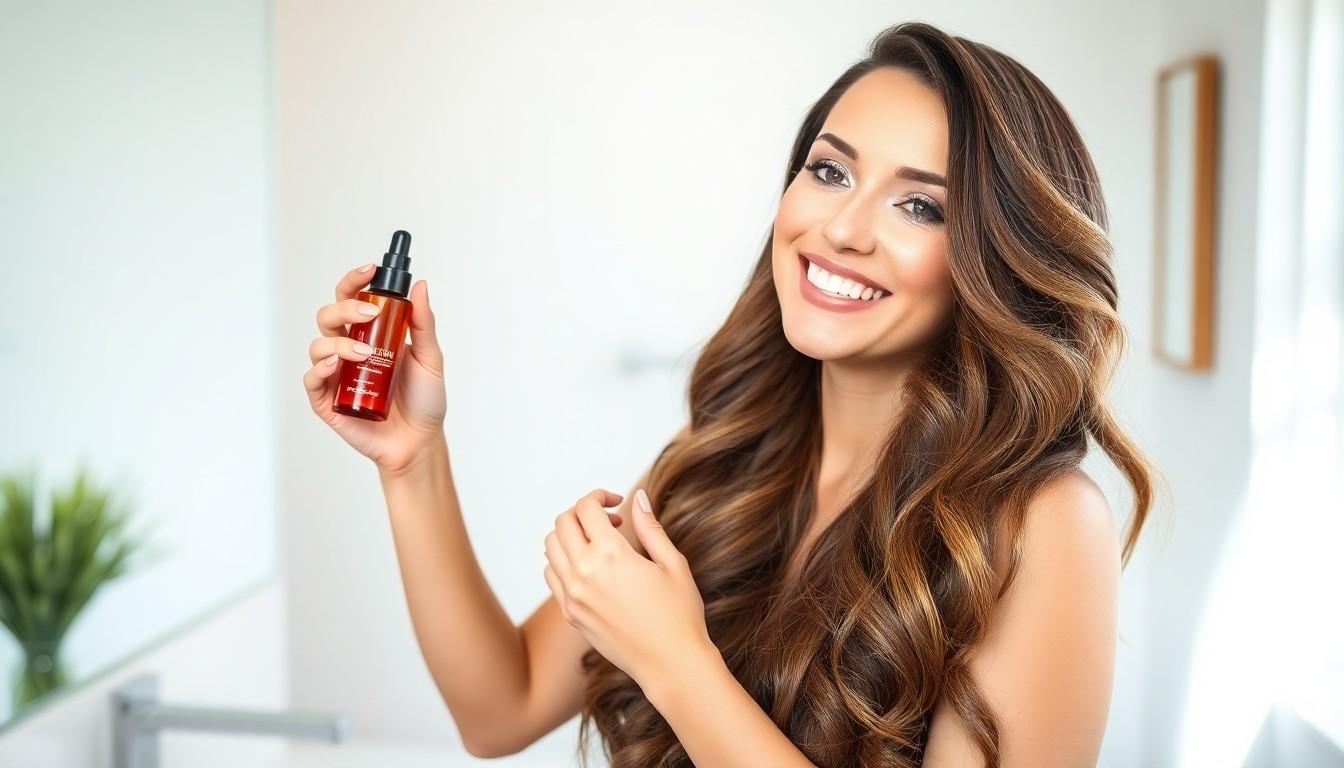Are you struggling with frizzy, damaged, or unmanageable hair? Hair serums might be the game-changer you’ve been searching for. These powerful hair products deliver targeted ingredients directly to your strands, helping to combat everything from dryness to split ends while adding incredible shine.
We’ve tested countless hair serums and discovered that many people aren’t maximizing their benefits simply because they’re applying them incorrectly. Using the right technique with the right product can transform your hair care routine and deliver those salon-worthy results you’ve been dreaming about. In this comprehensive guide, we’ll walk you through everything you need to know about hair serums – from selecting the perfect formula for your hair type to mastering the application process for optimal results.
Why Hair Serums Are Essential for Your Hair Care Routine
Hair serums have become indispensable in modern hair care routines for many compelling reasons. These lightweight formulations deliver concentrated benefits that other hair products simply cannot match. Here’s why incorporating a hair serum into your regimen is non-negotiable:
Protection from Environmental Damage
Daily exposure to pollution, UV rays, and harsh weather conditions can wreak havoc on your hair. Hair serums create a protective barrier that shields your strands from these environmental aggressors. The protective film they form prevents pollutants from penetrating the hair shaft, keeping your locks healthier for longer periods.
Deep Nourishment for Hair Strands
Unlike surface-level products, serums penetrate deep into the hair shaft to deliver essential nutrients. Their concentrated formulas contain vitamins, proteins, and amino acids that nourish hair from within. This deep conditioning effect addresses issues at their root rather than simply masking problems temporarily.
Frizz Control That Actually Works
Frizzy hair responds remarkably well to quality serums. The smoothing agents in these products effectively tame flyaways by sealing the hair cuticle. Most serums contain silicones or natural oils that coat each strand, preventing moisture fluctuations that cause frizz in the first place.
Heat Protection Properties
Frequent use of styling tools can severely damage hair without proper protection. Many serums offer thermal protection up to 450°F, creating a buffer between your precious strands and hot styling tools. This heat-resistant barrier significantly reduces damage from blow-dryers, straighteners, and curling irons.
Enhanced Manageability and Styling
Difficult-to-style hair becomes significantly more manageable with serum application. The slip and control these products provide make detangling easier and styling more efficient. Your styling efforts will last longer too, as serums help maintain your desired look throughout the day.
Restoration for Damaged Hair
Split ends and breakage find their match in reparative serums. These specialized formulations contain bond-building ingredients that temporarily seal damaged cuticles and prevent further splitting. Regular use can visibly improve the appearance of damaged hair while you grow out healthier strands.
Time-Saving Benefits
Incorporating a serum into your routine can actually save time in the long run. Well-nourished, protected hair requires less maintenance and fewer corrective treatments. Many users report spending less time fighting with their hair daily after establishing a consistent serum routine.
Choosing the Right Hair Serum for Your Specific Hair Type

Finding the perfect hair serum starts with understanding your unique hair needs. Different hair types require exact formulations to address their particular concerns and maximize benefits.
For Dry and Damaged Hair
Nourishing ingredients like argan oil, coconut oil, and shea butter are essential for dry and damaged hair types. These powerful moisturizers work to repair structural damage while restoring much-needed hydration to parched strands. Apply your serum to damp hair before styling to effectively lock in moisture and prevent further damage. Start at the ends where damage is typically most severe, then work your way up to the midsection, avoiding the roots to prevent an overly greasy appearance.
For Oily Hair
Lightweight, oil-free formulations are the best choice for naturally oily hair types. These specialized serums deliver benefits without adding unwanted weight or additional oil to your strands. Use just 1-2 drops of product for optimal results without overwhelming your hair’s natural oil production. Focus application only on the ends and mid-lengths, completely avoiding the root area where oil glands are most active and product buildup can occur.
For Curly and Frizzy Hair
Serums containing silicones, antioxidants, and plant extracts specifically target the unique needs of curly and frizzy hair types. These ingredients create a protective barrier that helps smooth the cuticle and tame unwanted frizz throughout the day. Apply your chosen serum to damp hair for maximum effectiveness, working methodically from the ends upward to the middle of your strands. This application technique enhances natural curl definition while providing superior frizz control under various humidity conditions.
For Fine and Thin Hair
Ultra-lightweight, non-greasy formulations are critical for fine and thin hair that can easily become weighed down. These specialized serums provide benefits without compromising volume or creating a limp appearance. Limit your application to a pea-sized amount, focusing exclusively on the ends and mid-lengths of your hair strands. Avoid applying product near the roots completely, as even minimal product in this area can make fine hair appear flat and lifeless at the crown.
Step-by-Step Guide to Applying Hair Serum Correctly

Now that you’ve selected the right hair serum for your hair type, it’s crucial to apply it correctly to maximize its benefits. We’ll guide you through proper application techniques for both wet and dry hair to ensure you get the most out of your product.
On Wet Hair
- Start with clean, damp hair after washing to enhance absorption of the serum into your hair strands. Freshly washed hair creates the perfect canvas for serum application.
- Use the appropriate amount based on your hair length – typically a dime-sized portion for shorter styles and a quarter-sized amount for longer locks.
- Warm the product between your palms by rubbing your hands together, which helps distribute the serum evenly when applied.
- Focus application on mid-lengths to ends of your hair, avoiding the roots completely to prevent unwanted greasiness and product buildup.
- Distribute evenly throughout your hair using either your fingers or a wide-tooth comb, making sure to coat the hair shafts properly.
- Proceed with styling as normal, whether you prefer to blow-dry, straighten, or air-dry your hair for a natural finish.
On Dry Hair
- Verify your serum is suitable for dry hair application, as not all formulations work effectively on already dry strands.
- Dispense sparingly – use the same small amount you would for wet hair to avoid overwhelming your style.
- Apply directly to mid-lengths and ends, keeping the product away from your roots to maintain volume and prevent an oily appearance.
- Target exact areas that need extra attention, such as frizzy sections or dry ends that require additional nourishment.
- Ensure even distribution by gently working the serum through your hair with fingers or a wide-tooth comb without pulling or tugging.
- Use for touch-ups throughout the day to refresh your style, tame flyaways, or add shine when needed.
Remember to always apply serum to clean hair for maximum benefits and protection against environmental aggressors. Gentle application techniques prevent unnecessary hair damage, while using the correct amount prevents your hair from looking weighed down or greasy.
Common Mistakes to Avoid When Using Hair Serums

Even with the best hair serums on the market, incorrect application can significantly reduce their effectiveness. Let’s examine the most common mistakes people make when using hair serums and how to avoid them.
Using Too Much Product
Overusing hair serum is perhaps the most common mistake that can instantly transform your hair from fabulous to flat. Just a dime-sized amount is sufficient for medium-length hair, with slightly more needed for longer or thicker hair types. Applying excessive product will cause your hair to look greasy, weighed down, and lifeless rather than shiny and healthy. Start with a minimal amount and gradually add more if necessary, remembering that you can always apply more but can’t remove excess product without rewashing your hair.
Applying to the Scalp
Hair serums are designed specifically for your hair strands, not your scalp. Applying serum directly to your roots or scalp area leads to unwanted product buildup, excessive oiliness, and potentially clogged hair follicles. Always focus your application from the mid-lengths to the ends of your hair where moisture and protection are most needed. The natural oils produced by your scalp already provide nourishment to the root area, making additional product unnecessary and potentially counterproductive.
Using the Wrong Type for Your Hair
Every hair type has unique needs, and using a serum that doesn’t match your exact hair characteristics can be ineffective or even damaging. Fine hair requires ultra-lightweight formulas that won’t weigh strands down, while thick or coarse hair benefits from richer, more nourishing options. Curly hair typically needs more moisture-focused serums, whereas straight hair might require more emphasis on shine and smoothness. We recommend researching the ingredients that benefit your exact hair type before purchasing a serum to ensure you’re investing in a product that addresses your particular hair concerns.
Best Times to Apply Hair Serum for Maximum Benefits

After Washing Your Hair
Applying hair serum to freshly shampooed hair yields the best results for most hair types. Clean hair creates the perfect canvas for serum absorption, allowing the product to penetrate effectively without competing with natural oils or product buildup. We’ve found that serums work more efficiently when they can directly reach the hair shaft, delivering nutrients and protective ingredients where they’re needed most. This timing helps prevent the weighed-down appearance that can occur when serums are applied to unwashed hair.
On Towel-Dried Hair
For optimal serum distribution, apply the product when your hair is still damp but not dripping wet. Towel-dried hair absorbs serum more effectively than completely dry hair, allowing for better penetration of the nourishing ingredients. Those with fine hair should particularly follow this approach, as applying serum to damp strands before other styling products prevents the hair from becoming flat. The moisture in towel-dried hair helps distribute the serum evenly throughout your strands.
Before Bedtime
Nighttime application offers unique benefits for hair serum users. Applying serum after your evening shower allows the product to work throughout the night while you sleep. This extended contact time maximizes the conditioning and repairing effects, resulting in noticeably softer and glossier hair when you wake up. Your hair experiences less environmental stress during sleep, giving the serum uninterrupted time to nourish and repair damaged strands.
Based on Your Hair Type
Different hair types benefit from varying application frequencies:
| Hair Type | Recommended Frequency | Focus Areas |
|---|---|---|
| Fine/Oily | 1-2 times per week | Mid-lengths to ends |
| Dry/Damaged | 3 times per week | Middle and ends |
| Curly/Wavy | 3-4 times per week | Throughout hair, focusing on ends |
Adjusting your application schedule according to your exact hair texture ensures you’re getting maximum benefits without overwhelming your strands. Environmental factors like humidity and heat exposure may require you to modify this frequency seasonally for best results.
How to Layer Hair Serum with Other Hair Products

Creating an effective hair care routine involves more than just applying products randomly. Layering your hair serum correctly with other products can maximize benefits and give you the best possible results. We’ve compiled expert advice on how to properly incorporate hair serum into your styling routine.
Apply Serum to Clean, Damp Hair First
Hair serums work best when applied to freshly washed, damp hair before any other styling products. This initial application creates a protective shield against environmental aggressors and ensures the serum delivers maximum benefits. Your damp hair will absorb the serum more effectively, allowing it to penetrate the hair shaft and work from within.
Use the Right Amount
The key to successfully layering hair products starts with using the correct amount of serum. Start with just 1-2 drops or a pea-sized amount, warming it between your palms for a few seconds. This warming technique helps the serum spread more evenly throughout your hair and prevents product buildup that can interfere with other styling products.
Focus on Ends and Mid-Lengths
Always apply hair serum starting from the ends of your hair, gradually working your way up to the mid-sections. Avoid the roots entirely when layering with other products, as this can cause excessive greasiness and weigh down your style. The ends of your hair need the most attention since they’re typically the driest and most damaged parts.
Distribute Evenly Before Adding Other Products
Ensure your serum is evenly distributed before adding additional products. Using a wide-tooth comb helps spread the serum thoroughly from the middle of your strands to the ends. This even distribution creates the perfect base layer for your other styling products to work effectively.
Add Moisturizers and Conditioners Next
After applying your hair serum, you can layer on moisturizers, leave-in conditioners, or styling creams. The serum creates a base that helps these subsequent products work more effectively. Your hair will be better prepared to receive additional moisture and styling benefits when the serum has already sealed and protected each strand.
Finish with Styling Products
Complete your layering routine with any styling products like mousse, gel, or hairspray. These should always come after your serum application to build upon the protective and nourishing base you’ve created. Your styling products will adhere better and last longer when applied over properly distributed serum.
Touch Up Throughout the Day
Hair serums aren’t just for your initial styling routine—they’re perfect for quick touch-ups throughout the day. Apply a tiny amount to dry hair to refresh shine and control any frizz that develops. Remember to use significantly less product for touch-ups than your initial application to avoid heaviness.
DIY Hair Serum Recipes for Natural Hair Care Enthusiasts

For those who prefer natural alternatives to commercial products, creating your own hair serum at home can be both cost-effective and customizable to your exact hair needs. DIY serums allow you to control exactly what goes into your hair care products while avoiding potentially harsh chemicals.
Key Ingredients for Homemade Hair Serums
Natural oils form the foundation of most DIY hair serums, each offering unique benefits:
- Coconut Oil: Provides deep moisturization and helps prevent protein loss in hair
- Argan Oil: Rich in antioxidants and essential fatty acids that strengthen hair and add shine
- Olive Oil: Hydrates and protects the hair shaft while reducing breakage
- Jojoba Oil: Closely resembles natural scalp sebum, helping to balance oil production
- Essential Oils: Add therapeutic benefits and pleasant fragrances (lavender for calming, rosemary for stimulating hair growth, tea tree for scalp health)
Basic DIY Hair Serum Recipe
Creating a simple yet effective hair serum requires just a few ingredients:
- Mix Your Base Oils: Combine 2 tablespoons of coconut oil, 1 tablespoon of argan oil, and 1 tablespoon of olive oil in a small bowl
- Add Essential Oils: Incorporate 5 drops of lavender essential oil and 5 drops of rosemary essential oil
- Blend Thoroughly: Ensure all ingredients are well combined for consistent benefits
- Transfer to Container: Store your homemade serum in a small glass bottle with a dropper for easy application
Application Tips for Homemade Serums
Apply your DIY hair serum using the same techniques as commercial products:
- Use on clean, freshly washed hair for optimal absorption
- Start with a small amount (1-2 drops) to avoid greasiness
- Focus application on the ends and mid-lengths, avoiding the roots
- Warm the serum between your palms before applying to enhance spreadability
- Distribute evenly using your hands or a wide-tooth comb
Remember to perform a patch test before applying any new DIY serum to ensure you don’t have an allergic reaction to any of the ingredients. Store your homemade serum in a cool place away from direct sunlight to preserve its beneficial properties.
Hair Serum vs. Hair Oil: Understanding the Differences

Many people confuse hair serums with hair oils, but these products serve different purposes in your hair care routine. Understanding their fundamental differences will help you choose the right product for your exact hair needs.
Composition and Texture
Hair serums are typically lightweight and silicone-based formulations with added proteins, keratin, and occasionally plant extracts like argan or moringa oil. Their consistency is typically thin and fluid, designed to spread easily through your hair without weighing it down. Hair oils, in contrast, are usually thicker, heavier products made from natural oils like coconut, argan, or jojoba that penetrate deeply into the hair shaft.
Purpose and Function
Hair serums primarily provide surface-level protection, creating a protective coating around each strand. They excel at controlling frizz, adding instant shine, and shielding hair from environmental factors such as dust, humidity, and UV rays. Many serums also offer heat protection when using styling tools. Hair oils focus more on deep nourishment and hydration, working to repair and strengthen hair from within by penetrating the hair shaft.
Application Method
The application technique differs significantly between these products. With hair serums, you’ll want to use just a few drops applied to mid-lengths and ends of towel-dried or dry hair, avoiding the scalp completely. Excessive use can lead to greasiness and limp locks. Hair oils often require more product and can be applied to the scalp as pre-shampoo treatments or to the entire length of hair for deep conditioning.
Best Uses
Hair serums work best for quick styling fixes, frizz control, and adding polish to your finished look. We recommend serums when you need immediate results and surface-level improvements. Hair oils shine in treatment scenarios where your hair needs deep conditioning, repair of damaged strands, or intensive moisture restoration over time.
Who Should Use What
Fine or oily hair types generally benefit more from lightweight serums that won’t weigh hair down or add excess oil. Curly, thick, or extremely dry hair often responds better to oils that can provide the deep nourishment these hair types typically need. People with combination hair might use both products strategically—serums on the ends for shine and frizz control, oils as occasional deep treatments.
Results Timeline
Hair serums deliver instant results, immediately smoothing the cuticle and adding shine to your hair. Their effects typically last until your next wash, providing temporary benefits. Hair oils work gradually, building up nourishment over time with consistent use, and can contribute to long-term hair health and strength with regular application.
The Science Behind How Hair Serums Transform Your Locks

Understanding Hair Serum Composition
Hair serums are specialized formulations designed to target exact hair concerns while improving overall hair health. Most serums contain silicones, oils, and active ingredients that work together to create a protective barrier around each strand. The silicones in hair serums effectively seal the hair cuticle, preventing moisture loss and environmental damage. Natural oils like argan or coconut oil penetrate deeper into the hair shaft, delivering essential nutrients directly to damaged areas. These powerful combinations create a multi-action approach that addresses both immediate styling needs and long-term hair health.
How Serums Interact With Hair Structure
When applied correctly, hair serums form a microscopic coating around each hair strand. This protective layer shields the hair from environmental aggressors including pollution and dust that can damage and dull your locks. Serums work by smoothing down the cuticle layer of the hair, which consists of overlapping scales that can lift and create frizz when damaged. By filling in gaps and irregularities in the hair cuticle, serums create a smoother surface that reflects light better, improving shine and reducing the appearance of frizz instantly.
The Absorption Process
The effectiveness of hair serums largely depends on proper application and absorption. Clean, freshly washed hair allows optimal serum absorption since product buildup and natural oils can create barriers that prevent serums from adhering properly. Damp hair is particularly receptive to serum application as the slightly open cuticles allow better product penetration. When warmed between your palms before application, the serum becomes more fluid and spreads more evenly throughout your strands. The motion of working from ends to mid-lengths ensures the most damaged parts of your hair receive the highest concentration of beneficial ingredients.
Protective Mechanisms at Work
Hair serums create a defensive shield against daily stressors that can compromise hair health. They act as a barrier between your hair and environmental factors by coating each strand with protective ingredients. Regular application contributes to long-term hair health by preventing cumulative damage from styling tools, UV exposure, and pollution. The preventative action of serums means they’re not just treating existing issues but actively working to maintain hair integrity over time.
The Balancing Act of Application
Finding the right amount of serum for your hair is crucial for maximizing benefits without weighing hair down. Typically, 1-2 drops provides sufficient coverage for short to medium length hair. Those with longer or thicker hair might need up to a pea-sized amount to achieve full benefits. Applying too much serum can counteract its intended benefits by making hair appear greasy or limp. The strategic application technique of focusing on ends and mid-lengths while avoiding roots prevents product buildup near the scalp where natural oils are already produced.
Conclusion
Hair serums are powerful allies in your hair care arsenal when used correctly. By selecting the right formulation for your hair type and applying it properly you’ll unlock the full potential these products offer.
We’ve walked through everything from proper application techniques to common mistakes DIY alternatives and the science behind how serums work. The key is consistency and finding what works for your unique hair needs.
Remember that less is more when it comes to serum application. With these tips and techniques you’re now equipped to transform your hair from frizzy and unmanageable to smooth glossy and healthy-looking.
Start incorporating these practices into your routine and you’ll soon notice the difference in how your hair looks feels and responds to styling.
Frequently Asked Questions
What are the main benefits of using hair serum?
Hair serums offer multiple benefits including frizz control, protection against environmental damage, heat protection from styling tools, enhanced shine, and deep nourishment for hair strands. They also help improve manageability, provide restoration for damaged hair through bond-building ingredients, and can save time in your hair care routine by reducing the need for corrective treatments.
How do I choose the right hair serum for my hair type?
Choose based on your specific needs: For dry/damaged hair, look for serums with argan or coconut oil. If you have oily hair, select lightweight, oil-free formulations and apply only to the ends. Curly and frizzy hair benefits from serums with silicones and antioxidants. For fine/thin hair, use ultra-lightweight serums sparingly to avoid weighing down your strands.
What’s the difference between hair serum and hair oil?
Hair serums are lightweight, silicone-based products that provide surface-level protection and immediate results like shine and frizz control. Hair oils are thicker, natural oil-based products that offer deep nourishment and long-term benefits. Serums work better for fine or oily hair, while oils are ideal for curly or dry hair types requiring intensive moisture.
How should I apply hair serum to wet hair?
Start with clean, damp hair. Use a dime-sized amount for shorter hair or quarter-sized for longer hair. Warm the product between your palms, then apply from mid-lengths to ends, avoiding the roots. Ensure even distribution by gently working the serum through your strands with your fingers or a wide-tooth comb.
How should I apply hair serum to dry hair?
Use the serum sparingly on dry hair to prevent heaviness. Apply a small amount to your palms, rub together, and focus on mid-lengths and ends. Target specific areas needing extra nourishment or frizz control. Avoid the roots and scalp area to prevent greasiness. Use light, gentle motions to distribute evenly.
What common mistakes should I avoid when using hair serum?
Avoid overusing product, which leads to greasy, lifeless hair. Never apply serum directly to your scalp, as this causes buildup and oiliness. Don’t use the wrong type of serum for your hair type—research ingredients that suit your specific needs. Applying too much pressure during application can cause breakage, so be gentle with your strands.
How often should I apply hair serum?
Application frequency depends on your hair type: Fine/oily hair should use serum 1-2 times weekly, dry/damaged hair about 3 times weekly, and curly/wavy hair 3-4 times weekly. Adjust based on environmental factors—use more frequently in humid conditions or when heat styling regularly. Always start with less and increase as needed.
Can I make my own hair serum at home?
Yes! DIY hair serums can be made with natural ingredients like coconut oil, argan oil, olive oil, jojoba oil, and essential oils. For a basic recipe, mix 2 tablespoons of a carrier oil with a few drops of essential oils. Always perform a patch test before use and store properly in a dark glass container away from direct sunlight.
When is the best time to apply hair serum?
Apply serum to freshly washed hair for optimal absorption. Towel-dried hair absorbs product more efficiently than dripping wet hair. Nighttime application allows the serum to work while you sleep, resulting in softer, glossier hair by morning. For touch-ups throughout the day, use a minimal amount to refresh shine and control frizz.
How do hair serums actually work on the hair structure?
Hair serums work by creating a protective barrier around each strand. The silicones and oils in serums smooth the cuticle layer of your hair, preventing moisture loss and enhancing shine. They fill in gaps in damaged hair, providing a temporary repair effect. This smoothing action reduces friction between strands, minimizing frizz and making hair more manageable.







